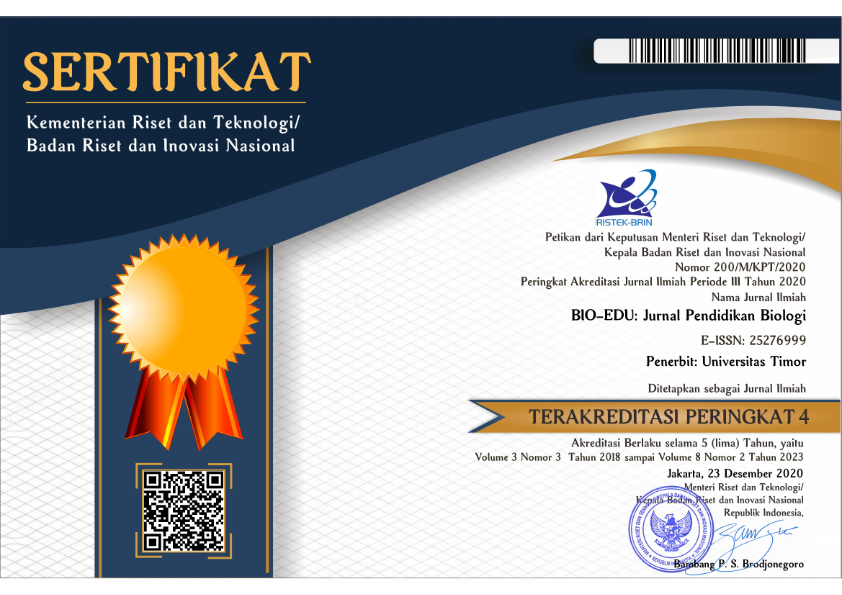STUDI LITERATUR TANAMAN WALISONGO (Schefflera arboricola) SEBAGAI TANAMAN PENETRALISIR POLUSI UDARA DAN BIOAKTIVITASNYA
DOI:
https://doi.org/10.32938/jbe.v8i2.3961Keywords:
walisongo plant, air pollution, bioactive compounds, medicineAbstract
Air pollution can cause health problems either directly or indirectly. This air pollution can occur indoors or outdoors. One type of plant that can reduce air pollution is the walisongo plant. In Indonesia, the walisongo plant (Schefflera arboricola) is also called the umbrella tree, which is a member of the Araliaceae family and has the potential as a medicinal ingredient. Information about this plant is still limited, so this research is essential to do. This research is a literature study research. The data was obtained online using the keywords walisongo plant or Schefflera arboricola. The data obtained were reviewed and synthesized. The walisongo plant originated from Taiwan and Hainan (China), spreading to various regions in Asia, tropical Africa, Florida, and Hawaii. This plant is easy to cultivate naturally (seeds) and artificially (cuttings and grafts). This plant is useful as an ornamental plant and an air biofilter to function as a neutralizer of air pollution. In addition, this plant has bioactive compounds found in its leaves and stems. The walisongo plant can be used as a neutralizer of air pollution, and its bioactive compounds can be used as medicinal ingredients.
References
Budiyono, A.(2001). Pencemaran Udara: Dampak Pencemaran Udara pada Lingkungan. Berita Dirgantara, 2 (1): 21-27.
CABI. (2019). Invasive Spesies Compendium. (Online), (https://www.cabi.org/isc/datasheet/48920#tosummaryOfInvasiveness), diakses tanggal 29 Juni 2022.
El-hagrassi, A. M., Osman, A. F., El-naggar, M. E., Mowaad, N. A., Khalil, S., & Hamed, M. A. (2022). Phytochemical constituents and protective efficacy of Schefflera arboricola L. leaves extract against thioacetamide-induced hepatic encephalopathy in rats. Biomarkers, 27(4): 375-394.
Gilman, E. F. & D. G. Watson. (1994). Schefflera arboricola Dwarf Schefflera: a series of the Environmental Horticulture Department Florida Cooperative Extension Service. Institute of Food and Agricultural Sciences: University of Florida.
Hakim, L. (2014). Etnobotani Dan Manajemen Kebunpekarangan Rumah: Ketahanan Pangan, Kesehatan Dan Agrowisata. Malang: Selaras.
Hakim, L., P. T. Putra, & A. L. Zahratu. (2017). Efektivitas Jalur Hijau dalam Mengurangi Polusi Udara oleh Kendaraan Bermotor. Jurnal Arsitektur NALARs, 16(1): 91-100.
Ismiyati, Marlita, D., & Saidah, D. (2017). Pencemaran Udara Akibat Emisi Gas Buang Kendaraan Bermotor. Jurnal Manajemen Transportasi & Logistik, 1 (3): 241-247.
Melek, F. R., Miyase, T., Khalik, S. M. A., & Elgindi, M. R. (2003). Triterpenoid saponins from Schefflera arboricola. Phytochemistry, 63(4):401-407.
Moore, K. A. & L. K Bradley. (2018). Nort Carolina Extension Gardener Handbook. (Online), (https://plants.ces.ncsu.edu/plants/schefflera-arboricola/), diakses tanggal 29 Juni 2022.
Munawaroh, Esti, Yuzammi, S. M. Solihah, & Suhendar. (2017). Koleksi Kebun Raya Liwa, Lampung: Tumbuhan Berpotensi sebagai Tanaman Hias. Jakarta: LIPI Press.
Mursinto, D. & Kusumawardani, D. (2016). Estimasi Dampak Ekonomi Dari Pencemaran Udara Terhadap Kesehatan Di Indonesia. Jurnal Kesehatan Masyarakat, 11(2): 163-172.
Ngoc, T. D. & Nguyen, T. L. (2019). Chemical Composition and Antimicrobial Activity of Essential Oils from the Leaves and Stems of Schefflera arboricola (Hayata) Merr. Collected in Vietnam. Journal of Essential Oil Bearing Plants, 22(5): 1401-1406.
Pettit, T., Irga, P.J., Abdo, P., & Torpy. F.R. (2017). Do the plants in functional green walls contribute to their ability to filter particulate matter?. Build. Environ, 125: 299–307.
Parseh, I., Teiri, H., Hajizadeh, Y., & Ebrahimpour, K. (2018). Phytoremediation of benzene vapors from indoor air by Schefflera arboricola and Spathiphyllum wallisii plants. Atmospheric Pollution Research, 9: 1083-1087.
Ramdhani, A., Ramdhani, M. A., & Amin, A. S. (2014). Writing a Literature Review Research Paper: A step-by-step approach. International Journal of Basic and Applied Science, 3(1): 47-56.
Silalahi, M. (2018). Keanekaragaman Tumbuhan Pekarangan dan Pemanfaatannya Untuk Prasarana Pembelajaran Di Sekolah PSKD 1 Jakarta Sebagai Salah Satu Usaha Konservasi. Jurnal EduMatSains, 3 (1): 1-20.
Stapleton, E., & Ruiz-Rudolph, P. (2016). The potential for indoor ultrafine particle reduction using vegetation under laboratory conditions. Indoor Built Environ., 27, 70–83.
Tarran, J., Torpy, F., & Burchett, M. (2007). Use Of Living Pot-Plants To Cleanse Indoor Air – Research Review. Proceedings of Sixth International Conference on Indoor Air Quality, Ventilation & Energy Conservation in Buildings – Sustainable Built Environment, Oct 28-31, 2007,Sendai, Japan, Volume III, 249-256.
Tjahjono, N. & Nugroho, I. (2018). Tanaman Hias Sebagai Peredam Kebisingan. Artikel telah diseminarkan di Conference on Innovation and Application of Science and Technology (CIASTECH 2018), Universitas Widyagama Malang, 12 September 2018.
Widyastuti, T. (2018). Teknologi Budidaya Tanaman Hias Agribisnis. Yogyakarta: CV Mine.
Ye, C. Q., Zhang, J. Y., Ye, Z. C., Xiao, M. T., Zhou, X. D., & Ye. J. (2020). A new lignan from Schefflera arboricola. Journal of Chemical Research, 44(9-10): 532–535.
Downloads
Published
Issue
Section
License
The Authors submitting a manuscript do so on the understanding that if accepted for publication, the copyright of the article shall be assigned to BIO-EDU: Jurnal Pendidikan Biologi and Departement of Biology Education, Universitas Timor as the publisher of the journal. Copyright encompasses rights to reproduce and deliver the article in all form and media, including reprints, photographs, microfilms, and any other similar reproductions, as well as translations.
BIO-EDU journal and Departement Biology Education, Universitas Timor, and the Editors make every effort to ensure that no wrong or misleading data, opinions, or statements be published in the journal. In any way, the contents of the articles and advertisements published in BIO-EDU are the sole and responsibility of their respective authors and advertisers.
Users of this website will be licensed to use materials from this website following the Creative Commons Attribution-ShareAlike 4.0 International License.



















